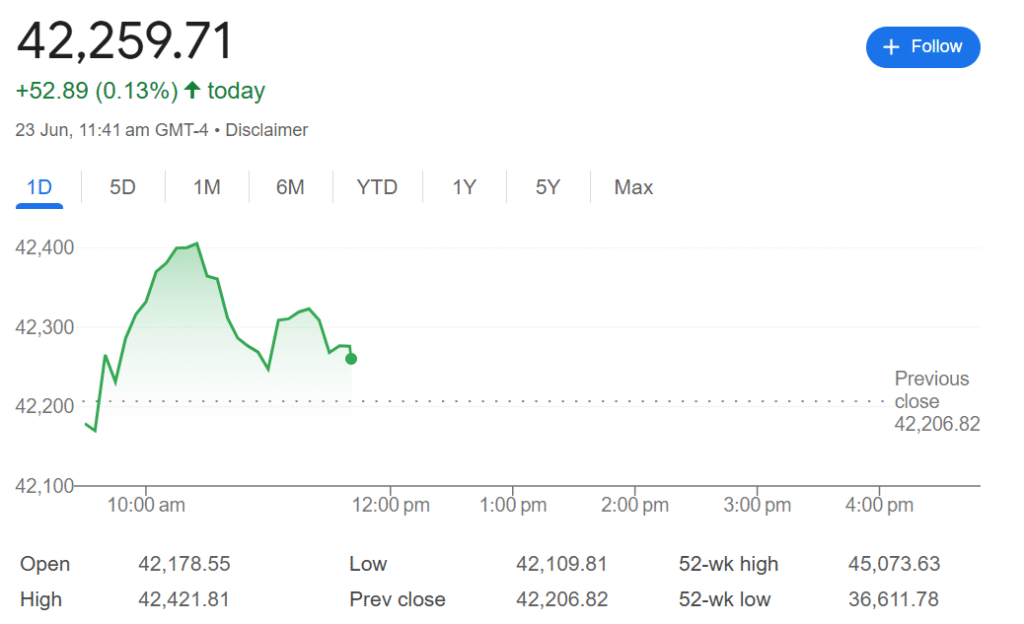Address
South Garo Hills Meghalaya
Address
South Garo Hills Meghalaya
Dow Jones Historical Data: For over a century, the Dow Jones Industrial Average (DJIA) has stood as a symbol of the U.S. economy’s strength and resilience. Whether you’re a day trader or a long-term investor, understanding the Dow’s historical data is crucial for putting today’s market movements into perspective.
From the roaring 1920s to the Great Depression, dot-com boom, 2008 crash, and COVID-19 pandemic, the Dow has reflected the economic heartbeat of America. In this 1860-word SEO-optimized article, we will break down:

The Dow Jones Industrial Average, created in 1896 by Charles Dow and Edward Jones, is a price-weighted index tracking 30 of the most influential publicly traded companies in the U.S. economy. Unlike the S&P 500, which is market-cap weighted, the Dow gives more influence to companies with higher share prices, regardless of size.
It originally tracked 12 industrial companies, mostly in railroads, oil, and steel. Today, it includes giants like Apple, Microsoft, and Walmart—representing nearly all sectors of the economy.

Let’s explore the Dow’s growth trajectory through key phases:
By 1929, the Dow had risen to 381 points, reflecting the speculative boom of the Roaring Twenties. But this euphoria didn’t last long.
Stock Market Today: Nifty 50 Trade Setup and Global Hedging Guide for Smart Investors
Circle Internet Group, Inc stock Price today
Tesla Stock Prediction 2025: Will TSLA Accelerate or Hit the Brakes?
Reddit Stock Price Prediction 2025: Can the Meme King Turn into Wall Street Royalty?
On October 29, 1929—Black Tuesday, the Dow plummeted, leading to the Great Depression. It took over 25 years for the index to return to its 1929 high.
📉 Key Lesson: Market speculation without fundamentals is unsustainable.
This period marked the U.S.’s transformation into a global economic superpower, and the Dow reflected post-war optimism.
Economic stagnation and rising oil prices triggered stock market volatility and investor pessimism.
📌 Key takeaway: Inflationary pressures can limit equity returns.
The 1980s and 1990s brought deregulation, tax cuts, and tech innovation, boosting corporate profits and investor confidence.
🖥️ The internet revolution sparked optimism, leading to inflated valuations by the late 1990s.
Tech companies with no profits collapsed, leading to a market correction. The 9/11 terrorist attacks added further instability.
🔍 Investor Note: Beware of investing in trends without proven revenue models.
Triggered by the subprime mortgage collapse and Lehman Brothers’ failure, this was the worst financial crisis since the Great Depression.
💡 Lesson: Leverage and poor regulation can wreak havoc on the economy.
By early 2020, the Dow hit 29,500—a five-fold increase in just 11 years.
Massive stimulus packages and ultra-low interest rates helped the stock market recover rapidly despite a global health crisis.
🏥 A testament to investor confidence in long-term economic resilience.
Investors shifted towards value and dividend-paying stocks, which dominate the Dow.
| Year | Event | Dow Level |
|---|---|---|
| 1896 | Inception | 40.94 |
| 1929 | Pre-Crash High | 381 |
| 1932 | Great Depression Low | 41.22 |
| 1954 | Recovers 1929 High | 381 |
| 1987 | Black Monday | -22.6% in 1 day |
| 1999 | Dot-Com Peak | 11,500 |
| 2009 | Financial Crisis Low | 6,547 |
| 2020 | COVID Crash & Recovery | ~29,000 |
| 2025 | Current | ~39,850 |
| Decade | Start | End | Return |
|---|---|---|---|
| 1930s | 248 | 150 | -39% |
| 1940s | 150 | 200 | +33% |
| 1950s | 200 | 679 | +239% |
| 1960s | 679 | 800 | +18% |
| 1970s | 800 | 839 | +4.9% |
| 1980s | 839 | 2,753 | +228% |
| 1990s | 2,753 | 11,497 | +317% |
| 2000s | 11,497 | 10,428 | -9.3% |
| 2010s | 10,428 | 28,538 | +173% |
| 2020s* | 28,538 | ~39,850 | +39% (so far) |
📈 Observation: Despite short-term volatility, the Dow has steadily grown over time.
Those who held onto their investments long-term—especially during crashes—saw significant returns.
Every bull market is eventually followed by a correction or recession. Understanding past patterns helps investors prepare for the future.
From industrials to tech, the Dow’s evolving composition mirrors America’s economic transformation.
The Dow has generally performed better than narrower or more speculative indices during downturns, proving the value of a blue-chip diversified strategy.
The Dow Jones Industrial Average isn’t just a stock index—it’s a living history book of the American economy. It tells stories of growth, collapse, innovation, and recovery. From under 50 points in 1896 to nearly 40,000 in 2025, the Dow’s historical data proves one thing: patient, informed investing wins over time.
Understanding historical patterns can help you weather future downturns and invest with confidence. So, the next time the market shakes, remember—the Dow has been here before. And it came back stronger.
On October 19, 1987 (Black Monday), the Dow fell 22.6%—the largest one-day percentage drop in its history.
It took 25 years—the Dow didn’t return to its 1929 level of 381 until 1954.
As of 2025:
Healthcare (J&J, UnitedHealth)
Technology (Apple, Microsoft)
Consumer Staples (Walmart, Coca-Cola)
Through platforms like Yahoo Finance, Google Finance, and official NYSE/Nasdaq archives.
Not precisely—but it offers invaluable context. History helps identify long-term trends, cycles, and investor behavior.
[…] Dow Jones Historical Data: A Deep Dive into the Stock Market’s Most Iconic Index (1896–2025) […]
[…] Dow Jones Historical Data: A Deep Dive into the Stock Market’s Most Iconic Index (1896–2025) […]
[…] Dow Jones Historical Data: A Deep Dive into the Stock Market’s Most Iconic Index (1896–2025) […]
[…] Dow Jones Historical Data: A Deep Dive into the Stock Market’s Most Iconic Index (1896–2025) […]